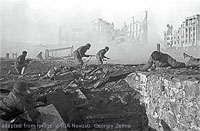‘Stalingrad’ Blockbuster Revives Russia’s Trauma, Glory

(Voice of America – James Brooke – November 19, 2013)
A foreign correspondent who has reported from five continents, Brooke, known universally as Jim, is the Voice of America bureau chief for Russia and former Soviet Union countries. From his base in Moscow, Jim roams Russia and Russia’s southern neighbors.
Seventy years have passed since the Battle of Stalingrad, the ferocious duel between Adolf Hitler and Joseph Stalin that cost nearly 2 million casualties. And yet, this month, a new generation of Russians are flocking to see the latest film called Stalingrad.
Ksenia Kuznetsova, a university student, just watched the movie in a multiplex cinema in a Moscow shopping mall.
“Thankfully I was born after that period and didn’t have to experience it,” she said. “But the characters in the film give you the feeling that you’re living it with them.”
Released in October, Stalingrad has become Russia’s biggest selling movie since the collapse of the Soviet Union one generation ago. The film is also doing well in China. In March, it will be Russia’s entry for an Oscar for best foreign-language movie.
Bloodiest battle
The real Battle of Stalingrad was a Soviet victory – but at a huge cost. With a total of 2 million casualties on both sides, Stalingrad is considered the bloodiest battle in human history.
Film critic Sergei Lavrentiev said that Stalingrad’s box office success reflects Russia’s enduring reverence for World War II sacrifices, a respect that now is passing to a new generation.
“For the youngsters, who are the main spectators in the cinema now, it’s totally unusual,” said Levrentev. “They never saw such Soviet films about war. And also, they haven’t even some feeling about how bad was that war for the Russian people, for Soviet people.”
Stalingrad is Russia’s first movie shot in 3D for Imax. Oddly, the film works a love story into all the carnage.
Katya, another Moscow moviegoer liked the plot and special effects: “I really liked the movie, it was filmed and produced very well. The actors did a great job, and of course it grabs you by the heart because it reflects all of our strength and history.”
‘A positive light’
Russia’s government entirely financed the film’s $30-million budget – part of a Kremlin drive to make modern movies that show Russian history in a positive light.
Today, the city of Stalingrad goes by the name of Volgograd. Leveled during the war, it has been entirely rebuilt.
Dominating the new city is patriotic statue, Motherland Calls.
Standing twice as high as the Statue of Liberty, the statue was the largest in the world when unveiled by Soviet authorities in 1967.
Since the 8,000-ton monument of steel and cement was erected on clay soil, however, it has started to lean. In a strong wind, it sways.
City residents wish that after spending millions on a Hollywood-style movie, Russia’s government would invest in stabilizing the monument to Russia’s war dead in the real Stalingrad.
